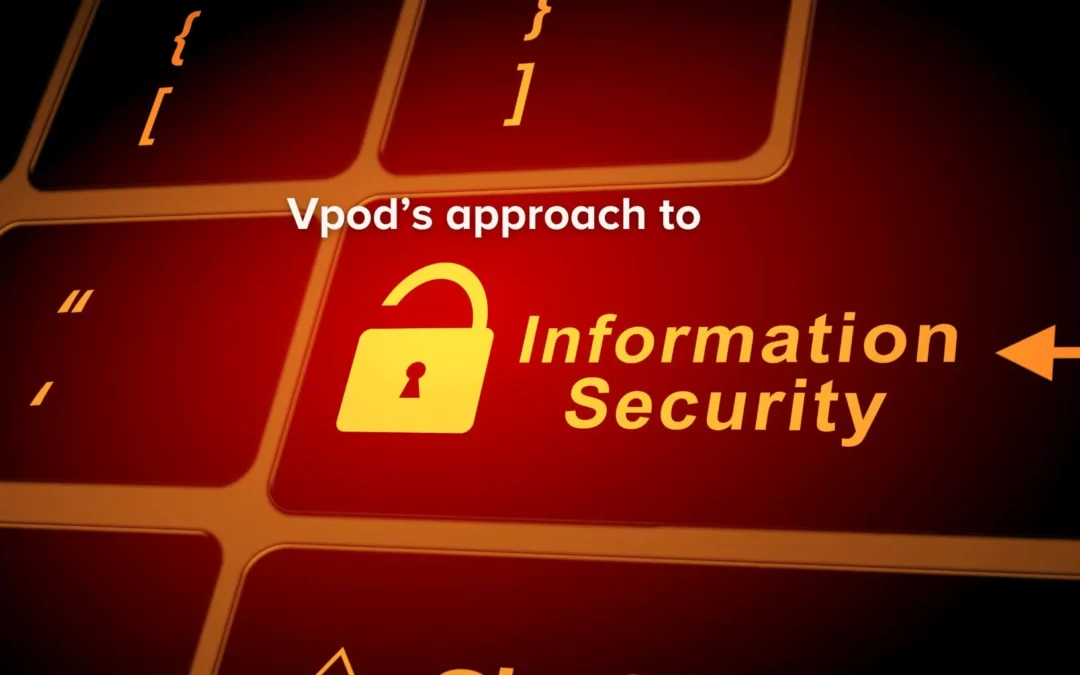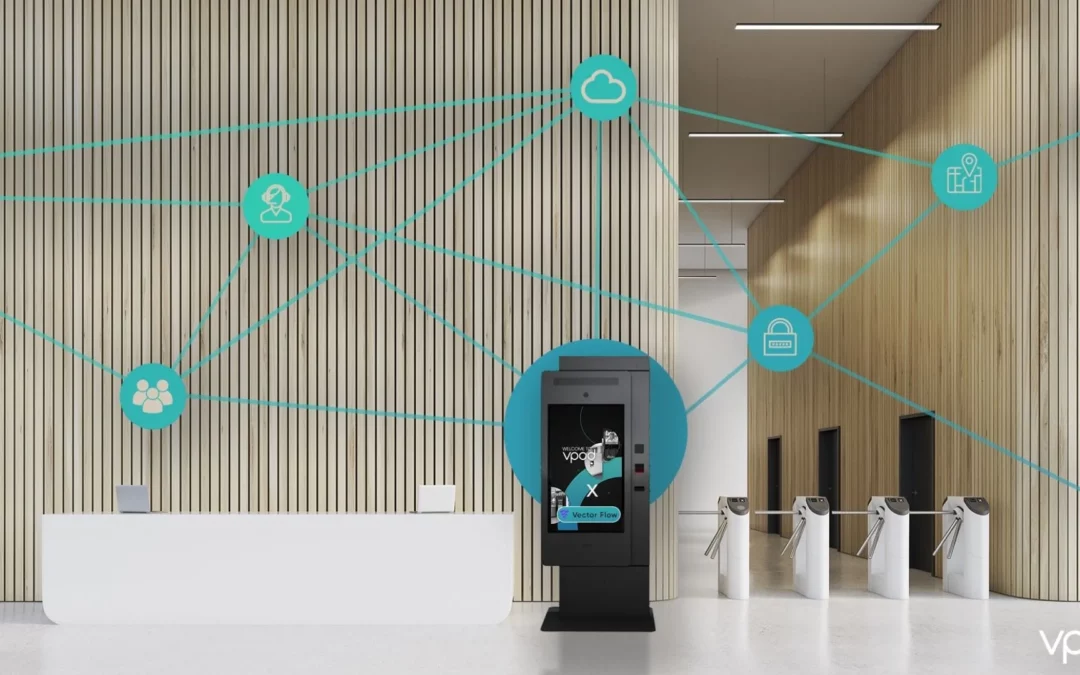In today’s blog, we want to focus on facilities managers’ insights and how to improve the visitor experience and workplace efficiency. We will cover the key visitor management techniques from meeting booking and finishing the meeting, to writing a visitor policy, with everything in between. Lastly, we will also cover:
- How can Facilities Management add value?
- Visitor management with the 4 R’s
- A list of useful tools for you to start engineering your reception
1. Efficient Background Operation
To implement the best visitor management strategy, ensuring an efficient background operation is a crucial technique to start with. With a help of a visitor management system, automated visitor flows can let your front desk focus more on other complicated manual tasks.
Host meeting booking
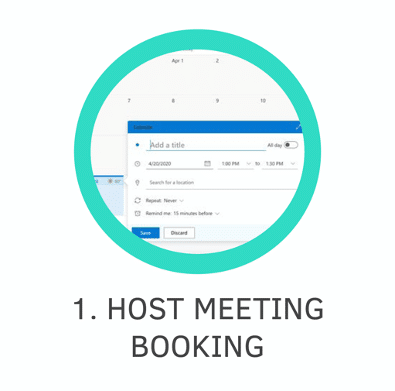
Imagine you are setting up your next meetings for your visitors in Microsoft Outlook, you can make this process more efficient with the help of a meeting room booking system.
Before the meetings start, employees can simply access Outlook in the usual way and send a meeting invitation. It’s a simple visitor management technique without too much learning.
The Facilities Manager can decide how to offer meeting rooms. Self-serve allows employees to choose their own room. Facilities Managers have full administration over this process and can implement a method to suit their department and organisation.
During this process, vendors can be added to the booking. Front of house staff can manage any additional needs, such as hot drinks, parking spaces or catering.
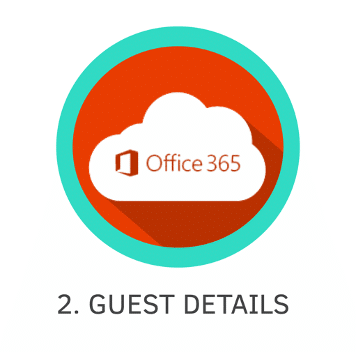
Taking your guest’s details
Saving your time in collecting visitor details is a crucial technique in visitor management. Re-consider the efficiency if you are using visitor sign-in books to collect visitor details on their arrival.
The simple technique here is, to implement a visitor management solution that automatically collects visitor details when you set up a meeting in Outlook.
After the meeting details have been inputted into Outlook, guest details are taken, and the reception staff is fully aware of who is coming to the building.
However, make sure your visitor management is GDPR compliant while taking guest details. Implementing a visitor management system can make sure your visitor data is stored, handled and anonymised in accordance with GDPR.
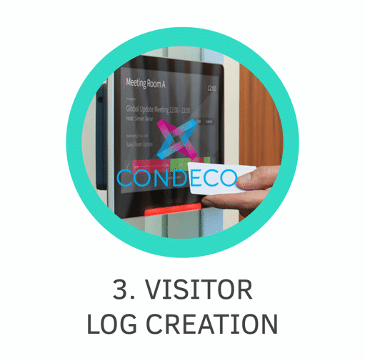
Saving visitor’s data: Visitor log
Visitor logs can be saved in the cloud-based visitor management systems, meaning that when a visitor returns to your building, their previous registration will be remembered and is always up to date. Saving time for your visitor ensures a great experience for them.
2. A Warm Welcome
The second important visitor management technique you need is to make your visitors feel welcome, and are being greeted professionally. An unprofessional front desk service will leave a negative impact on your business.
Recognise your guests
Once your visitors arrive at your building, how do you know who they are and what are their reasons for visiting? Recognising your visitors is an important technique here for a great visitor experience and ensuring your building’s safety.
Does your reception team recognise your guests right away? To ensure your visitors are greeted professionally, you can:
Use dedicated receptionists – It could be people-intensive if you have a large number of visitors. If your receptionists need to handle administrative tasks as well, delivering first-class customer service might not be easy at busy times. Any single point of failure is putting your business reputation at risk.
Combine people and technology – However, using people is expensive. Vgreet visitor management system is capable of upgrading your reception to a flexible reception service that combines people and technology to deliver the best visitor experience. Adding visitor management software that can assist your front desk and reception staff are fully aware of who is coming to the office, handling up to 20,000 visitors a month capacity. Your visitors will always be recognised and greeted professionally.
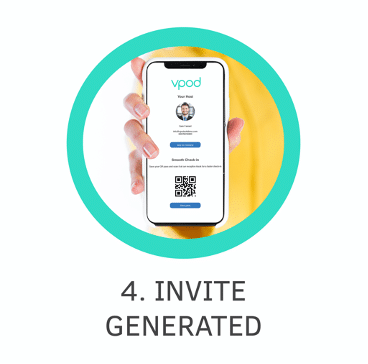
Impress them with a slick meeting invite
Impress your visitors by sending them a branded invitation that enables a touchless check-in. An invite with details of your meeting plus directions to your office.
Documents can be shared prior to arrival, including health and safety information, wi-fi passwords, contact details and on-location codes of conduct. Leaving your visitor completely comfortable with their upcoming meeting, knowing exactly what is expected of them before they arrive.
3. Check your visitors in fast, easy, and safely
Now, visitors want to check in fast and easily through a simple process without waiting in a long queue, or waiting for your reception to check their identity. But what are the techniques you can use to do that?

Pre-registration
A simple technique here to streamline your visitor check-in is pre-registering your guests. Any extra information you need from the visitors can be gathered before they arrive at your office, saving time and manual processes for checking in.
Planning your visitor management strategies with pre-registration to:
- Ask your visitors how they intend to travel to your building, and offer car parking spaces
- Review and sign documents before they enter your lobby.
- self-certification details, leaving your business confident that health and safety rules and regulations are being followed.
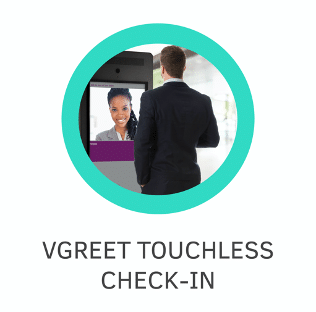
The touchless check-in
It has become crucial that staff and visitor safety needs to be taken into consideration. With appropriate steps you take to keep the football minimal, your reception staff can stay behind the scenes or be relocated to other tasks.
The pandemic brought many anxieties about sharing germs or touching surfaces that others may have touched. Apart from planning social distancing, visitor management systems use facial recognition sensors, QR code check-in, temperature screening technology, and voice recognition to streamline the check-in process and reduce the contamination risk.
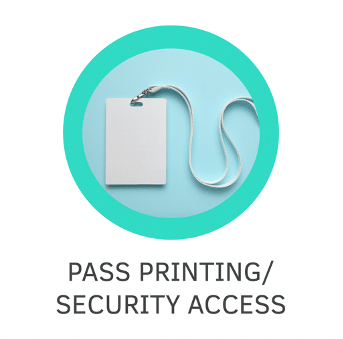
Pass printing & security access
We have different types of visitors coming to your building, and being able to identify the visitors can prevent unexpected visitors from putting your staff and guests’ safety at risk.
Pass printing is an additional visitor management technique to ensure the building’s security. It helps you identify different types of visitors including unauthorised visitors.
Vgreet visitor management system’s access control integration can also let you monitor real-time visitor numbers on your site. Control which areas of the building your visitors have access to, including restricted level access and door entry.
4. Contact the Host
So now your visitor has checked in, and letting your host be notified in time is a simple technique that is too often forgotten. In most cases, the reception team will ring the host, and then will tell your guest which room they are going to, or the host will come to collect the visitors.
Does it sound familiar to you? Once the visitors have checked in, hosts need to be notified instantly. Hosts have the responsibility to be prepared for their arrival, greeting the visitors in the meeting room on time.
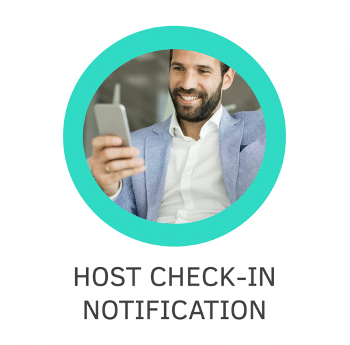 Automated Guest notification
Automated Guest notification
Use a visitor management system with a client arrival notification system that notifies hosts by email, Slack or text, reducing visitors’ waiting time at the reception.
Meanwhile, the reception staff is able to focus on other tasks. If your guest is running late, the host should be notified right away.
5. Find the Meeting Room
Lastly, as part of your visitor management strategies, don’t forget to make sure your visitors won’t be wandering around your building, looking for their meeting room. Either you choose to put very clear signs in your buildings or use an indoor wayfinding solution.
After a visitor has checked in, show your visitors an interactive map with the direction to their meeting room. Visitors know which floor to choose in the elevator and which direction to turn once they arrive at the correct level without asking your reception team.
6. Write a clear visitor management policy
Last but not least, writing a clear visitor policy is a vital visitor management technique for you to secure your visitors, staff, workplace, and confidential information. How to write a visitor management policy? Any company-specific visitor management policy needs to be accessible with regard to visitor management GDPR compliance. A great visitor management policy is usually for the following purposes:
Visitor access restrictions
Common areas can be open to visitors, but we need a clear visitor management policy to state your visitors’ access to certain areas of your building. In this case, you need to make sure your visitors won’t distract your employers or enter any restricted area. Vgreet visitor management system is fully integrated with Proxyclick’s access control system, so only certain levels or rooms can be accessed.
You can read more about Vgreet’s visitor access control systems here.
Visitor record
Vgreet visitor management system keeps a digital visitor log to help track visitors. Facilities managers should be aware of where and when the visitors are in your building in case of an emergency.
Visitor Identification
According to Workplace’s visitor management policy template, we have many different types of visitors coming to the office every day. Different types of visitors entering your building can be:
- Employee
- VIP
- Contractor
- Supplier
- Deliveries
Identify different types of visitors with a visitor pass and give a clear visitor management policy that states different permission to different levels of visitor entry:
- Employees – you might enable their QR code to work with the Access Barriers
- Contractors – you might restrict to certain floors
- Suppliers access to floors like Catering to one floor
- Cleaners to all floors but only out of hours
Visitor management policies for wi-fi, non-disclosure, or any other information
A visitor management policy includes visitor use of Wi-Fi, restriction on photography/recording, or anything you need them to know. Before arriving at your building, your visitors have pre-registered themselves and signed your visitor management policy. Saving a lot of time at the reception.
How can Facilities Management add value to these visitor management techniques?
Facilities Managers can add immense value to their businesses by rethinking and re-engineering their workplaces. Now more than ever, Facilities Managers need to be innovative in their visitor management techniques to ensure employees and visitors can access buildings safely. Cost and productivity are major factors when adding value to the FM department.
It’s important to note that there are many stakeholders that should be considered in workplace strategy. the pandemic gave each department a vested interest in workplace strategy.
Each stakeholder has to play their own part in order to keep a business running effectively. Never before have mass businesses seen this type of pressure upon them. As such, it is integral that teamwork is incorporated into the Facilities Manager’s workplace strategy.
Facility management with the 4 R’s
2020 has brought upon the world the biggest crisis management challenge to date. Departments are working together to tackle ongoing legislative changes and health and safety rules. At the same time, they are working flat out to keep businesses afloat amidst economic uncertainty.
The 4 R’s are workplace strategies and techniques that enable Facilities Managers to take control of ongoing uncertainty, keep budget spending down, and add value as a department.
REACT
The first R, React, involves Facilities Managers working with other key departments to deal with the immediate emergency. React to threats to business operations and begin to understand the situation.
Many FMs experienced the React stage in March 2020, when the UK went into lockdown for the first time. Examples of how FMs and key departments may have reacted to this crisis include:
- Instructing employees to work from home, and supporting them to do this
- Implementing a safety plan for employees who needed to stay at work (key workers)
- Responding to changes in employment law (furlough, holidays, self-certification)
- Ensuring business-critical operations still go-ahead
- Responding to IT support requests
- Ensuring data security is upheld while devices are offsite
- Keeping empty buildings secure and safe
- Deal with disrupted commercial contractual obligations
- Introduce new communication methods for employees, including video
It’s integral for Facilities managers to be a part of a wider team, working together with other departments during crises. All departments specialise in particular areas, so working together decreases the time to respond, recover and re-engineer the crisis.
In the event of an unexpected crisis, it is normal for response teams to begin the situation in react mode. During this time, teams will work in a tense environment as they react to the ever-changing situation. As teams become more confident with the immediate emergency, they begin to move into the second R: Respond.
RESPOND
Once the immediate emergency is under control, crisis teams are able to respond to the situation at hand and come up with a plan to recover from the crisis. In the case of the pandemic, the response was guided by Governmental legislation and regional directives that were in force locally.
Examples of how crisis teams may respond to the pandemic are:
- The introduction of working from home policy
- The development of new online communication tools
- Workplace risk assessment and action plans
- Amendments to commercial contracts; new deadlines or commitments
- Rotas for management and maintenance of empty buildings
- Review and changes to current budget spend
In the response process, working together in a crisis team to respond to different aspects of the pandemic can hugely benefit each department and the business. Each response involves a mixture of skills and knowledge, for example:
Workplace risk assessment and action plans
This challenge has been allocated mainly to HR departments. Acas, the employee and employer rights professional body, details safe working to be a responsibility of HR departments. This is largely due to the fact that employee safety is the responsibility of HR teams.
However, workplace health and safety are not usually at the forefront of an HR strategy. As such, it has led to Facilities and HR departments working closely together to achieve shared goals – keeping employees safe and an organisation afloat.
RECOVER
The recovery stage of crisis management is when businesses must implement advanced visitor management techniques to recover from the pandemic, in a way that benefits the business but also the employees. The phrase “new normal” is the term used by many; what is the new normal for businesses?
At this stage, crisis teams have had many months of adapting business methods to accommodate legislative and local Covid-19 rules. During the recovery, stage businesses should implement methods to help the business to recover and survive the new normal.
Examples of how a crisis team may look to recover from the pandemic are:
- Updated and new HR policy
- Update visitor management policy
- Introduction of workforce bubbles
- Workplace safety methods
- Introduce cloud-based storage
- Updated security policies
- Safe workplaces
- Updated sanitisation and cleaning methods
Many businesses may choose to stop after the third R. Throughout the pandemic, they may move between three Rs as the situation changes and develops. However, you need to evaluate your visitor management techniques and measure if an easy visitor management system can help you easily adapt to future changes.
The fourth R, Re-engineer, is an opportunity for change, innovation, and value addition. Re-engineering workplace strategy will add value to Facilities Management as a department, and engage key stakeholders to develop the future workplace.
RE-ENGINEER
Re-engineering the workplace is an opportunity for innovation and change in workplace strategy. Having worked closely with multiple departments in 2020 has brought a great opportunity for Facilities Managers to engage these stakeholders. Create a workplace strategy that meets the needs of each, enables easy processes and, most importantly, keeps building occupants safe.
The future of the workplace must address multiple challenges from many stakeholders, including:
- Combine working from home with safe office working
- Be security friendly, keeping company assets safe from theft or misuse
- Provide a safe experience in commercial properties
- Be a solution that can be applied to multiple properties
- Must adhere to Governmental health and safety rules
- Incorporate a contactless digital offering
- Provide psychological safety to building occupants
- Make the best of space restrictions
- Be cost-effective
- Be efficient
Thinking ahead
Businesses are under pressure to deliver workplace solutions that are efficient, cost-effective and safe. Re-engineering your workplace strategy with visitor management techniques in mind will ensure each of these goals is achieved.
Whilst a daunting task, Facilities Managers have a unique opportunity to adopt new visitor management techniques for workplaces! The digital offering of a simple visitor management system meets the needs of multiple stakeholders, departments and employees.
There is also an opportunity to implement a solution that Facilities Managers don’t have to consider the four R’s or react to changes in the future. They can simply use the current strategy to adapt.
Summary
Applying visitor management techniques is significant for facilities managers, a visitor management system solves complicated problems at uncertain times.
Keep these 6 visitor management techniques in mind to deliver the best visitor experience:
- Efficient background operation
- A warm welcome
- Touchless check-in
- Contact the host
- Find the meeting room
- A great visitor management policy
Facilities Managers must work with stakeholders closely to ensure an effective workplace strategy that adds value to the business.
Teamwork is integral to effective visitor management strategies. Working together with other departments and sharing skills and knowledge will ensure that businesses implement a visitor management solution that meets the needs of stakeholders, the organisation, and employees.
Re-engineering the workplace gives an opportunity for innovation and change. With the help of an easy visitor management system, you do not need advanced techniques to deliver the best visitor experience.
More Resources
- The ultimate guide to visitor management systems
- Click here to download our free and tailored visitor management guide for your persona
Interested in learning more visitor management techniques?
Wonder how an easy visitor management system works?
